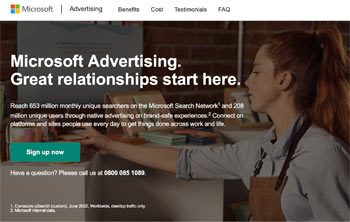Geotargeting marketing has become an essential form of marketing that allows businesses to target consumers based on their location. This can be done through various means, such as GPS tracking, IP addresses, or even cell phone towers. For businesses, geotargeting marketing can be a great way to target potential customers who are in close proximity to their business. This can be especially useful for businesses that have a brick-and-mortar location. However, before you start geotargeting your marketing efforts, there are a few things you should know. In this blog post, we will provide a beginner’s guide to geotargeting marketing, so that you can make the most of this powerful marketing tool.

What Is Geotargeting?
Geotargeting is a marketing technique that involves targeting specific geographical locations with marketing campaigns. This can be done in a number of ways, such as targeting local customers with ads and content that is relevant to their area, or targeting a wider audience with ads and content that is relevant to a specific country or region.
There are many benefits to geotargeting marketing, such as being able to reach a target audience more easily, increasing the chances of conversion, and reducing marketing costs. However, it is important to ensure that your campaigns are relevant to the location you are targeting, otherwise you could end up wasting time and money on a campaign that no one cares about!
If you're thinking about using geotargeting in your next marketing campaign, make sure to do your research and plan carefully to make the most of this powerful tool.
Define Your Audience by Their Location
Understanding your audience is critical to the success of your marketing campaign. Without knowing who your target market is, you can't create content that resonates or make decisions about where to allocate your marketing budget. Fortunately, thanks to advances in data and technology, it's easier than ever to research and identify your target market.
One way to segment your target market is by location. This can be done using geographic information from customer surveys, website visitor data, social media data, and more. By understanding the locations of your target market, you can tailor your marketing message and strategies to better reach them.
For example, if you know that a large portion of your target market is located in the United States, you can adjust your website accordingly. This might involve adding local photos or videos, using American spellings and slang, and providing content that appeals to a US audience (such as news stories about recent events).
If you're targeting a global audience, on the other hand, you'll need to take a different approach. In this case, it's important to create content that is universally appealing and easy to understand regardless of location. This might involve using simple language, avoiding culturally specific references, and providing translations for key content areas.
No matter what type of audience you're targeting, though, remember that location isn't the only thing that matters. You'll also need to consider other factors like age, gender, interests, income level, etc. when crafting your marketing message.
Research the Demographics of Your Target Location
There are a number of ways to research the demographics of your target location. The most common way is to use online resources such as the census website or other government websites. You can also use commercial databases, which will often provide more detailed information.
Another way to research demographics is to speak to people who live in the area. This can be done through surveys or informal conversations. If you know someone who lives in the area, they may be able to give you some insight into the local demographics.
Finally, you can also look at data from social media platforms. This can be a good way to get an idea of the age, gender and interests of people in a particular location.
Consider the Language Spoken in Your Target Area

If you're looking to market your business to a specific geographic area, it's important to consider the language spoken in that area. Depending on your target market, you may need to adjust your marketing materials and website content to reflect the dominant language(s) spoken in that area.
For example, if you're targeting Spanish-speaking consumers in the United States, you'll need to make sure your website and any advertising materials are in Spanish. Similarly, if you're targeting French-speaking consumers in Canada, you'll need to ensure your content is in French. Failing to do so could result in lost customers and decreased sales.
Invest in Local SEO for your Website
As the online world becomes increasingly competitive, businesses are turning to local SEO to help them rank higher in search engine results pages. Local SEO is a branch of SEO that focuses on optimizing a website for local searches.
There are a number of benefits of investing in local SEO for your website. Perhaps the most obvious benefit is that it can help you attract more local customers. If your website ranks high for relevant local keywords, searchers in your area are more likely to find and click on your listing. This can lead to more traffic and more customers for your business.
What Do You Advocate?
In addition to attracting more customers, investing in local SEO can also help you build brand awareness and credibility in your community. When potential customers see your website ranking high for relevant searches, they’ll be more likely to trust your brand and consider doing business with you.
Lest not forget, investing in local SEO can also help you beat out the competition. If other businesses in your area are not investinng in local SEO, you could have a major competitive advantage by ranking higher in search results pages.
If you’re looking to attract more local customers and beat out the competition, investing in local SEO is a smart move for your business.
Use location-based social media platforms

Foursquare
As a business owner, you should be using every tool at your disposal to reach your target market. Location-based social media platforms like Facebook, Twitter, and Foursquare are great ways to connect with potential and current customers who are in close proximity to your business.
Here are a few tips for using location-based social media platforms to reach your target market:
1. Use geo-targeted keywords in your posts
Make sure you include relevant keywords in your posts so that people searching for businesses like yours can find you easily. For example, if you’re a restaurant in New York City, use keywords like “food,” “dining,” or “NYC restaurants” in your posts.
2. Check-in often and offer incentives
Encourage customers and employees to check-in at your business on Foursquare and other location-based social media platforms. You can offer incentives like discounts or freebies for those who do. This is a great way to generate word-of-mouth marketing for your business.
3. Use geo-targeted ads
Social media platforms like Facebook and Twitter offer very effective advertising tools that allow you to target users based on their location. This is an extremely powerful way to reach potential customers who are within close proximity to your business.
Utilize Google Maps and Google For Small Business
Google Maps and Google For Small Business are both powerful tools that businesses can use to reach their target audience.
Google Maps allows businesses to target ads to users based on their location. This is a powerful way to reach potential customers who are near your business or who are searching for businesses like yours.
Google For Small Business is a free listing service that allows businesses to control how they appear in search results. This is important because it allows you to manage your online reputation and ensure that potential customers can find your business.
Both Google Maps and Google For Small Business are both excellent tools for businesses that want to geotarget their marketing efforts. By utilizing these tools, businesses can reach their target audience more effectively and grow their customer base.
Geotargeting ads on Google and Microsoft Ads
Geotargeting ads on Google Ads and Microsoft Ads (Bing) allows businesses to target customers in specific locations with ads that are relevant to them. This type of marketing can be very effective, as it allows businesses to reach potential customers who are more likely to be interested in what they have to offer.

Here are the steps when creating geotargeted ads on Google and MS Ads.
- Make sure that your ads are relevant to the location you’re targeting. This means including local keywords and phrases in your ad copy.
- Bid on keywords that are specific to the location you’re targeting. Doing so will help ensure that your ad appears in search results for those keywords.
- Consider using negative keywords for locations that you don’t want your ad to appear in. For example, if you’re a local business targeting customers in your city, you might want to use negative keywords for other cities in your state or country.
By following these tips, you can create effective geotargeted ads on Google and Microsoft Ads that will help you reach potential customers in your target location.
Create Marketing Content That Appeals to your Target Audience
When you're creating marketing content, it's important to keep your target audience in mind. What appeals to them? What do they want to see? Answering these questions will help you create content that resonates with your audience and helps you achieve your marketing goals.
- Consider what you want to achieve with your marketing content. Are you looking to increase brand awareness? Drive traffic to your website? Generate leads? Once you know your goal, you can tailor your content accordingly.
- Next, take a look at your target audience. Who are they? What are their interests? What motivates them? Understanding your audience will help you create content that speaks to them directly and encourages them to take action.
- Finally, consider how you can use geotargeting to reach your target audience. Geotargeting allows you to deliver targeted content to users based on their location. This can be useful if you want to reach local audiences or if you're targeting a specific country or region.
By keeping these three things in mind, you can create marketing content that appeals to your target audience and helps you achieve your business goals.
A Beginners Guide To Geotargeting Marketing - Final Thoughts
Make sure you have a clear understanding of your target audience. Consider the costs associated with geotargeting marketing and whether it is worth the investment. Think about how you will measure the success of your geotargeting marketing campaign. By keeping these things in mind, you can create a successful geotargeting marketing campaign that will help you reach your target audience.

